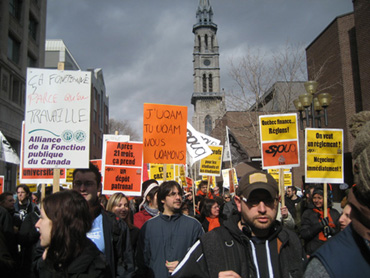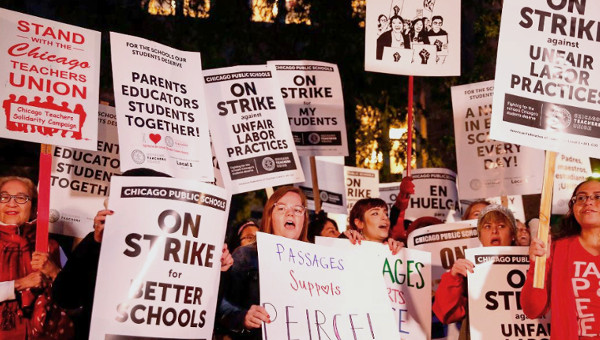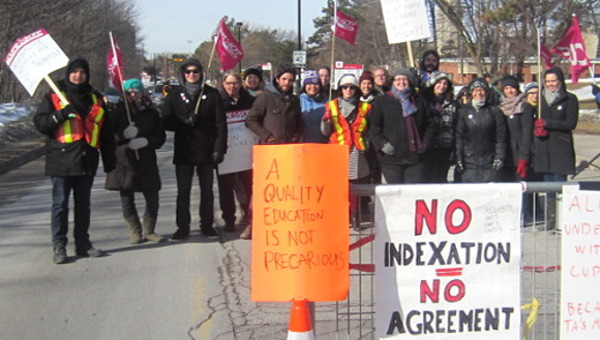The Struggle Has Its Own Dynamic
The Professors’ Strike at the Université du Québec à Montréal
The seven-week strike of professors at the Université du Québec in Montréal (UQAM) ended on April 24, 2009 in a significant, if partial, victory. It is, unfortunately, a rare event in contemporary Quebec, and, for that matter, in North-America. It is therefore worth looking into this conflict to see what lessons it might offer of use to other unions.
Unfavourable Context
Before presenting the results of the strike, it is important to note that the context leading up to it did not at all appear favourable to a strike, even less to a victorious outcome.
Despite their public image as critical thinkers, university professors (with significant exceptions) are a socially rather conformist group in relation to the dominant ideology. The intellectual life of a society is very much influenced by the balance of class forces, and that balance in Quebec has shifted strongly in favour of the dominant class over the past quarter of a century. Rare are the professors who adopt dissident positions in relation to the established order or who show an active commitment to the interests and struggles of the popular classes. In addition, the very occupation of university professor, at least the way it is structured in our society, tends to encourage individualism, competition, the all-out quest for personal recognition.
Several other factors were working against the transformation of the professors into militant strikers. Well-paid compared to the mass of wage and salary earners and with a degree of prestige in society, they also enjoy considerable autonomy, even power at work – power vis-à-vis students, assistants, secretaries. UQAM, which was established in 1969 in a period of intense nationalist and labour mobilization (in the early 1970s Quebec, especially its burgeoning public sector workers, held the world record for days lost in strike per capita), is characterized by a significant degree of self- and co-management: departmental assemblies in practice hire new colleagues; they evaluate periodically the work of their members; they recommend their promotion; the entire academic side of the university is self-managed or co-managed with the administration. Professors elect the rector (officially appointed by the provincial government) and have minority representation on the (formally government-appointed) administrative council. This power is an undeniable advantage for the professors and a positive for the university’s academic mission, but it also tends to undermine consciousness of the interests that oppose professors and administration, and, as a consequence, to undermine the members’ identification with their union, their own collective organization.
Financial Crisis – Real-Estate Adventure
The UQAM faculty contract came to term in May 2007, and the union at once presented the administration with a plan for its renewal. But this was followed shortly by the eruption of a major financial crisis at the university: the administration, it was revealed, had embarked on a “private-public-partnership” real-estate adventure (on the background of a real shortage of space and of the government’s refusal to finance adequately new construction) that landed the university in an almost $400-million hole. Meanwhile, the provincial government, in accordance with its policy of imposing budgetary discipline on the universities (all of which are mainly government-funded in Quebec – tuition is the lowest in North America, thanks mainly to repeated student strikes over the years), was withholding $65-million in grant money for the years 2005-08 for the universities daily functioning, until it could prove its ability to return to a balanced budget. (The retained money had to be borrowed from the banks: the university’s punishment was thus to make a gift to the banks of the interest payments.) By the fall of 2009, after publication of a report by the provincial comptroller confirming the government’s own partial responsibility for the disaster, the latter finally agreed to assume the real-estate debt and freed the withheld grant. But the university administration, in concert with the Quebec Minister of Education, continued to insist on financial austerity and budget cuts. Even though the new rector recognized the historic underfunding of UQAM compared to Quebec’s other universities, he refused to press the government for more money, citing the need for the university “to show itself responsible to its partners,” by which he meant the government and the business community, certainly not the university’s employees and students.

With the real-estate crisis resolved (though not its political fallout), the economic crisis hit Canada in the early fall of 2009, bringing public deficits, rising unemployment and downward pressure on wages. The context was, therefore, not encouraging for additional funding from the government, and especially not for salary increases and hiring more full-time professors, the union’s main demands. (70% of undergraduate courses at the university are taught by part-time staff, paid by the course – essentially cheap, precarious labour. These teachers belong to a separate union.) Even when government finances were in a better state, the government did not hesitate in December 2005 to decree its 400,000 employees back to work, to ban public-sector strikes for five years, and unilaterally to impose working conditions and wages. (This is part of a general tendency in Canada to deny public-sector workers the right to strike in practice, while still according the right in theory. Quebec governments have been especially vicious in this respect since the early 1980s, and the unions have not adequately reacted. Universities are considered part of the para-public sector and were not covered by the 2005 decree.)
Another major obstacle was the decline, over a number of years, of union life in SPUQ (le Syndicat des professeurs et professeures de l’Université du Québec à Montréal). This has been a general tendency in Quebec trade-unionism for the past quarter century, linked to a series of major defeats, but also not unrelated to the union federations’ – there are three major federations in Quebec – shift to a strategy of “social partnership.” But the weakening of SPUQ had also its own particular causes. Thus, in 1966 the union, without serious resistance, agreed to major “temporary” concessions in the context of the government “budget crisis,” largely invented to justify the neoliberal shift to balanced budgets and tax cuts, and onto which the leaders of the union federations signed at a notorious “socio-economic summit.” SPUQ’s president at the time told a general assembly that “we have clearly been living above our means.” These concessions, in particular the increase of the average class size from 33 to 41, predictably became permanent. Subsequent collective agreements were negotiated without mobilization of the membership and brought no significant gains.
It is, therefore, not surprising that many members were not aware of the importance of the union for their work conditions. On the contrary, there was a marked tendency to identify closer with the administration. The weakness of union life manifested itself, among others, in the reluctance of members to take on union functions, the rarity of discussions of union matters at departmental meetings, the weak attendance at union meetings, and the choice of the professors’ representatives in the co-management bodies at times to ignore union positions. (For example, the professors’ representatives in the administrative council voted for the disastrous real-estate project, despite the union’s open opposition to it.) For its part, the administration did not hide its low regard for the union, failing to send it the required information within the allotted time, ignoring its opinions, violating the collective agreement.
The situation on the eve of the strike was not all bad. The union enjoyed some important advantages that contributed to the positive outcome of the conflict. But before going into these, we should present that outcome.
A Positive Outcome
Most of the non-monetary clauses of the new collective agreement were successfully negotiated during the spring of 2008, with the all-important exception of the status of faculty deans, whom the rector wanted taken out of the bargaining unit to become members of the administration. (They were union members, elected by the faculty members.) The uncertainly about the fate of the university due to the real-estate crisis did not really allow to negotiate the monetary clauses until the fall of 2009. But with that out of the way, the union came up against the administration’s refusal to pursue the negotiations. The main monetary demands were a salary increase of 5, 3, and 3% over the three years of the proposed contract, from June 2007 to May 2010 (to reach the level of the other Montreal universities – UQAM salaries trailed by about 12%) and the hiring of 300 permanent professors beyond the 1010 existing posts.
Among other monetary demands were an increase from $4,000 to $8,000 of the remuneration for extra courses voluntarily accepted, $8,000 being the salary of temporary lecturers for each course; payment by the university of an equal sum when a professor uses the money from extra courses to finance student grants; an increase in remuneration for sabbatical years from 80% to 90% of regular pay (other universities pay 100%); a start-up grant for new hires equal to the remuneration of two courses, and other things.
In face of the administration’s refusal to negotiate (its excuses changed over time: it first had to wait for the appointment of a new negotiating team, then for an outside report comparing UQAM’s conditions to those other universities; then for its five-year budget, due the end of May, a date that raised the spectre of a lockout over the summer), the union’s general assembly voted a “study day” for February 16, which was followed by four scattered strike days (19, 25, 27 February and 10 March) and then almost six straight weeks of strike. From the week of March 10, a negotiator from the Ministry took direct charge of the talks. But after a first, insulting “final offer” that the faculty membership rejected by a vote of 91%, negotiations treaded water until the final week. (The union finally lodged a complaint with the Labour Commission over bad-faith bargaining.)
The agreement finally adopted by the general assembly will add 146 new posts in the remaining three years of the contract (ending May 2012) and by the end of that period will have brought professors’ salaries to the level of most other universities in the province (this raise is in addition to any increase that public sector workers obtain, something all university staff in the province get). Other gains include a one-time 3% back-to-work compensation, sabbaticals paid at 90%, compensation for extra courses raised to $6,000. And the government abandoned its demand for a commission to look into the workload of professors at the university (the idea being that they do not work hard enough). This agreement will cost the provincial government some $20-million a year, a not insignificant amount, but hardly comparable to the $205-million it announced for renovation of the Montreal Casino during the strike.
In the column of gains, one has to include also the fact that the union forced the government (which, after all, has the money) to negotiate directly with it and that it was able to avoid a special law, a threat bandied both by the Minister and her negotiators. The union was able to convince the government that the political cost would be too high.
On the negative side, the union recognized the principle of deans as members of the administration. The specific powers of the deans are to be negotiated by a joint union-administration commission, but it is not clear what will happen if the committee cannot reach an agreement or if its proposal is not acceptable to the union or to the administration. The administration presents this change as reflecting the need to decentralize management, bringing it closer to the faculties. But a large part of the professors see it as a first step toward reducing the autonomy of the departmental assemblies and of what remains of the democratic character of UQAM, forcing it into the traditional, top-down mould of the other universities. Another negative element was the non-retroactive character of the salary increase.
Could more have been won by continuing the strike? The union’s executive committee knew from sources inside the Quebec National Assembly that the threat of a special law was, at least for the moment, merely a bluff. In the meanwhile, each additional day of the strike added to the pressure on the government, threatening the integrity of the winter semester. It is undoubtedly true that the strikers were tired. Yet, massive majorities repeatedly – 91% the last two times – decided to continue the strike. It is true, of course, that the latest government offers would have reduced the majorities in favour of continuing the strike. But was a majority to be ruled out? Hoping no doubt to strengthen the members’ will, the union president had made the error of presenting the last demand for additional strike days as the last she would ask. In general, the executive tended to underestimate the determination of the rank and file. In the months and weeks preceding the strike, it had not really believed a strike possible and was reluctant to even pronounce the word at assemblies. Moreover, the final agreement was presented as a majority proposal of the executive, without the minority explaining its dissidence, something that would have favoured a debate about the possibility and wisdom of continuing the strike. Be that as it may, the final agreement was adopted by a vote of 91% and is widely seen by the members as a significant victory.
But this balance sheet would be incomplete without mentioning the gains that the strike brought for union life, gains that, if consolidated – a major challenge in itself – will significantly change the balance of forces within the university. The strike renewed union life, strengthening the identity of the rank and file with their organization, their sense of community, their solidarity. For example, the professors’ general assembly made a satisfactory agreement for the language teachers, a group of only 50 people, also members of the union, but who bargain separately, a condition of their own agreement. The strike also brought out many new union activists, especially among the younger professors, a development that should finally allow a solution to the perennial problem of finding a replacement for the older generation, ever closer to retirement, who, for lack of an alternative, have long monopolized union leadership posts.
The strike also brought closer together the different unions at the university. The inter-union meetings never functioned so well. More concretely, the professors’ strike played a key role in allowing the support staff’s union (SEUQAM) reach a satisfactory agreement (adopted by a majority of 98%) without a strike. Its president paid homage to the “SPUQ effect.” The administration also showed itself surprisingly open to extra pay for the student auxiliaries for the work they would do after the formal end-date of their contracts (although it has since demanded conciliation in its bargaining with that union, something the union opposed.)
The strike had a definite radicalizing effect on the professors, whose collective action defied the university and public authorities by refusing to take responsibility for crisis of which they were not the authors. This undoubtedly made a significant contribution to the civic, political education of the students and other employees and reaffirmed the UQAM critical heritage, very present at its origins but which had been eroded over the years. It remains to be seen whether SPUQ’s example can inspire the public sector unions that will soon be entering into new negotiations with the government.
The Elements of Victory
Many factors contributed to the favourable outcome of the strike, but the central element, without any doubt, was the mobilization and solidarity of the members. Nothing could have made up for weakness at this level. Indeed, the contribution of the other factors lay, to a large degree, in their strengthening the resolve of the union rank and file. The majorities in favour of pursuing the strike, that continued to rise – 78%, 85%, 91%, 91%, a rare phenomenon in union life – sent a very strong message to the administration and the government and encouraged support from outside – students, the opposition parties, other professors’ unions, personalities in the arts and sciences.
Hence the critical importance of the sustained participation of the membership in the strike activities – the various committees; the picket lines – privileged arenas of discussion, debate and for renewing solidarities; the militant disruption of classes given by some of the temporary lecturers; the noisy demonstrations at the end of each picketing shift outside the administration building in support of the union negotiators; the almost-weekly general assembly to discuss the strike and decide on whether to continue; the marches and demonstration involving the whole union and sometimes the other UQAM unions; the many bussed visits of members to the offices of the Liberal deputies from Montreal ridings, to the National Assembly in Quebec, to the office of the head of Treasury; the discussion and information workshops, etc.
Another important factor was the continued presence among the professors of a significant leftwing current, even if it was considerably diminished by the years. Since the right took little interest in the union, the executives of past years have been made up of people who generally leaned to the left. Hence the consistent and firm positions in defence of the university’s democratic character and the decisive refusal to assume the consequences of the real-estate fiasco and the economic crisis. These positions rallied the left-leaning members, dispersed as they were, and their support at the delegates’ and general assemblies helped to sway the less decisive majority. It is also worth noting that SPUQ does not suffer from a tendency, present in many unions, for leadership to become entrenched, something that tends to encourage caution and conservatism. For university professors, to accept a union leadership post, even if it frees them of other duties, is not seen as a privilege but as disruption of a career is generally well-liked. People thus usually accept these tasks out of genuine commitment to the mission of the university and their colleagues’ interests.
The conduct of the strike itself was very democratic, something also quite rare in union life. The almost-weekly general assemblies that informed the membership about the negotiations, the initiatives of the executive, the activities of the committees, and decided on whether to continue the strike made a huge contribution to maintaining the members’ determination. (At the same time, it is clear that general assemblies do not lend themselves well to searching debate, something that requires discussion in small groups, in workshops. To some degree, this role was played by discussions on the picket line.) The democratic functioning also allowed left-leaning members outside the executive to correct certain of its overly cautious positions, taken out of fear the membership would not follow them.
The gradual (rather too gradual for some, including this author) nature of the mobilization allowed a rank and file, of which a majority at the start found the very idea of a strike strange and frightening, to build up its confidence and courage. The mobilization really began with the union’s response to the real-estate crisis. The leadership, supported by a series of general assemblies, made clear from the very start that the employees and students should not pay for the irresponsibility of the administration. And despite the shameful weakness of the new rector, who insisted on demonstrating that the university could be “responsible,” the union’s general assembly unanimously rejected the budget cuts proposed by an outside (very well-paid, by the university, and quite incompetent) accounting firm and which the rector accepted and even wanted to better. Even if the rank-and-file mobilization at this stage was limited – most of the effort came from the executive – the positions adopted prepared the ideological terrain for the struggle for a new collective agreement.
On December 4, 2008, once the government had assumed, at least in principle, the real-estate debt and paid out the withheld parts of its grants to the university, the union launched a campaign – posters, leaflets, bulletins, buttons, resolutions, “visits” by the delegates’ council en masse to the rector and the administrative council – “Ten Weeks for a Settlement.” But the union did not say what it would do if the settlement did not come. Despite the impatience of some members, the executive refused to ask the membership for a strike mandate, avoiding even to say the terrible word out loud. The proposal for a first strike day, bashfully named a “study day,” for February 16 came from the floor of the delegates’ council of January 23 and was adopted by a large majority. This decision was then confirmed by a general assembly on January 29 by a majority of 88%. The general assembly convened on the study day voted by a majority of 76% to give the executive a mandate of four scattered strike days, if necessary; the general assembly of March 10 voted 85% in favour of the first full week of strike; and so forth until April 24.
Another important factor was the “generous,” social, or non-corporatist nature of the demands, especially the demand for 300 additional posts. In fact, the union from the start presented its entire proposal as a plan for the university’s renaissance. But it was the demand for new posts that gave the claim real credibility. That demand made a special contribution to the morale of the strikers, reinforcing their sense of the justice of their struggle. It also greatly facilitated the search for outside support, in particular from the students, who went on strike after the administration obtained an injunction against closed picketing (even the management students struck for a week, an historically unprecedented event), but also from the political opposition and the cultural and scientific community.
The determination demonstrated by the strikers, the weight of the outside support, and the obvious justice of the union demands prevented the government from making good its threat of a special law. It obviously found the price too high. From that point of view, the union enjoyed a certain advantage in the links some professors had with members of the political, cultural and intellectual elites of the province. Being themselves members of the intellectual elite, they also got more press coverage, though not necessarily favourable, than a strike of similar dimensions might ordinarily have obtained.
It is also important to mention the role played by SPUQ’s affiliation to a union federation, the Centrale des syndicats nationaux (CSN). SPUQ is the only professors’ union in Quebec to be thus affiliated and so be part of the larger labour movement. This is a legacy of the university’s popular origins. [SPUQ was the first professors’ union in Canada. It went through a four-month strike in 1976 (the only one until 2009), mainly over issues of self-management.] Over the years, many members have questioned the value of the affiliation to the CSN and especially the considerable sums paid to it in dues. But the strike gave a convincing response. Besides the considerable political and financial support, the value of the CSN’s advisors in the negotiations and the mobilization is hard to exaggerate.
Finally, there was the behaviour of the other side, the administration and the government. In a conflict, the respective force of the opposing sides is always a dialectical relationship. The deeply disrespectful attitude of the administration and the government – the injunction, the threat of a special law, the refusal for so long to negotiate, the first ridiculously insulting “final offer” of the government, rejected out of hand by a majority of 91% – was not only a constant provocation that reinforced the spirit of the strikers but it also apparently blinded the opposing side to the possibility of splitting the professors in order to undermine their mobilization.
The Struggle Has Its Own Dynamic,
Hard to Evaluate Without First Engaging in It
A static evaluation, like a photo, of the balance of forces during the months preceding the strike would have been rather discouraging for the union and would not have allowed a proper measure of the potential for mobilization, nor the prediction of a victory. That is undoubtedly one of the main lessons of the strike – the key importance of leadership in the labour movement. For one must first engage the struggle before deciding what is really possible. A union leadership that for its own reasons prefers to avoid confrontation will always, except in exceptional periods of acute popular struggle, be able to justify its refusal to seriously mobilize.
In this connection, one cannot do better than quote from Antonio Gramsci, the great Marxist thinker with a rich experience of labour struggle:
“In reality, one can “scientifically” predict only the struggle, but not its concrete unfolding, which can only be the result of forces in opposition and in continuous change, forces that in no case can be reduced to fixed quantities, because in them, quantity is constantly changing into quality. In reality, one foresees to the degree that one acts, that one applies a conscious effort and one thus contributes concretely to create the “foreseen” result. The act of foreseeing, therefore, shows itself to be not an act of scientific knowing but the abstract expression of the effort one makes, the practical way of creating a collective will.” (Translated from the French edition of Prison Notebooks)
The quality of leadership (including that of the adversary), its strategy, its intelligence, its democratic character, and many other traits, are all part of the complex equation, in a state of constant change, which that constitutes the balance of forces. Leadership cannot create miracles where conditions are absent. But its weakness can bar the way to possible victories. Hence the importance of a Left in the unions, and particularly of an organized Left.
It is not a question of encouraging adventures, but rather of rejecting the strategy of so-called “social partnership,” increasingly present in the Quebec union movement from the 1980s and based on the idea that workers and bosses share fundamental interests. A Left that understands the fundamentally antagonistic interests opposing workers and management, and so the central role played by the balance of forces in the situation of workers, also understands that the struggle, once engaged, tends to follow its own logic.
Once engaged in collective struggle, members are reluctant to squander their investment by pulling out too quickly, before testing its real potential. (This in part explains the increasingly stronger votes for continuing the strike.) Once engaged, the struggle itself reinforces solidarity, because it becomes the vital condition of victory. The strike frees up time, in particular on the picket lines, to engage in calm exchange with colleagues from different departments – exchange about the demands of the strike and its progress, about problems of work, about social and political matters, about life. This solidarity, this renewed sense of community of work colleagues, that capitalist society and the administration do their best to keep apart and compete among themselves, is a source of happiness that strengthens the will and compensates for the uncertainty and fatigue of the struggle.
The collective assertion of dignity; the fact of defying unjust, and often stupid, authority; the newly-acquired force to influence conditions that only yesterday were “objective” and seemingly unchangeable – these are sources of enjoyment that emanate from the struggle itself and that give the courage to question accepted wisdom and the dominant ideology. All these elements, to some degree, take their place alongside the initial demands of the strike as motives for pursuing the struggle.
Struggle, therefore, has a transforming effect on its participants. This effect, which enters directly in the balance of forces, can neither be foreseen nor measured by a static analysis, conducted before the struggle is actually engaged. •
David Mandel teaches political science at UQAM. At the time of the strike, he was a member of the union’s executive council and chairperson of the picketing committee.





